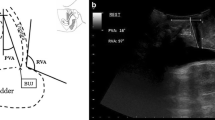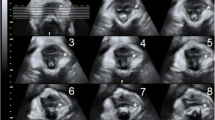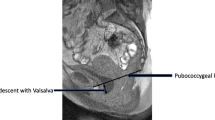Abstract
Introduction and hypothesis
We correlated intrarectal pressure parameter recordings during the second phase of labour in primiparous women with postpartum pelvic floor (PF) complaints to try to define a critical pressure threshold for the occurrence of permanent PF injury.
Methods
Using a microsystem device, the duration of bearing-down efforts, the area under the pressure curve and the peak pressure during bearing-down efforts were continuously recorded in 43 women with spontaneous delivery (group one) and in 17 women with forceps-assisted delivery (group two). PF complaints were assessed using ICS-validated questionnaires established before delivery and 14 ± 6 months after delivery.
Results
Postpartum PF complaints were not significantly different between the groups. The first and second phases of labour were longer in women of group two. The three parameters measured were not correlated with the baby’s weight or mode of delivery. The duration of bearing-down efforts was correlated with difficulty voiding and lower abdominal discomfort in women of group one only. The area under the pressure curve was correlated with feeling of urgency to void, urge incontinence, drops escape, decreased frequency of orgasm and difficulties in reaching orgasm in women of group two only. Peak pressure values were not correlated with any PF dysfunction.
Conclusions
Intrarectal pressure parameters during second phase of labour show no significant correlations with obstetric parameters, but were significantly correlated with some urinary and sexual PF complaints 14 months after spontaneous and forceps-assisted delivery with a higher incidence of significant correlations in women of group two with forceps-assisted delivery, probably because of the longer first and second phases of labour.


Similar content being viewed by others
References
DeLancey JO. The hidden epidemic of pelvic floor dysfunction: achievable goals for improved prevention and treatment. Am J Obstet Gynecol. 2005;192(5):1488–1495.
Viktrup L, Lose G. The risk of stress incontinence 5 years after first delivery. Am J Obstet Gynecol. 2001;185:52–87.
Wilson D, Dornan J, Milsom I, Freeman R. UR-CHOICE: can we provide mothers-to-be with information about the risk of future pelvic floor dysfunction? Int Urogynecol J. 2014;25:1449–1452.
Meyer S, Salchli F, Bettaieb H, Hohlfeld P, Achtari C. Continuous recording intrarectal pressures during the second phase of labor. Prog Urol. 2012;22(8):487–494.
Wilson PD, Herbison RM, Herbison GP. Obstetric practice and the prevalence of urinary incontinence three months after delivery. Br J Obstet Gynaecol. 1996;103:154–161.
MacArthur C, Lewis M, Knox EG. Health after childbirth. Br J Obstet Gynaecol. 1991;98:1193–1195.
Meyer S, Schreyer A, De Grandi P, Hohlfeld P. The effects of birth on urinary continence mechanisms and other pelvic-floor characteristics. Obstet Gynecol. 1998;92:613–618.
Lukacz ES, Lawrence JM, Contreras R, Nager CW, Luber KM. Parity, mode of delivery, and pelvic floor disorders. Obstet Gynecol. 2006;107:1253–1260.
Burgio KL, Zyczynski H, Locher JL, Richter HE, Redden DT, Wright KC. Urinary incontinence in the 12-month postpartum period. Obstet Gynecol. 2003;102:1291–1298.
Casey BM, Schaffer JI, Bloom SL, Heartwell SF, McIntire DD, Leveno KJ. Obstetric antecedents for postpartum pelvic floor dysfunction. Am J Obstet Gynecol. 2005;192:1655–1662.
Fritel X, Fauconnier A, Levet C, Bénifla JL. Stress urinary incontinence 4 years after the first delivery: a retrospective cohort survey. Acta Obstet Gynecol Scand. 2004;83:941–945.
Stanton MC, Strahle A, Fethney J. Leaking urine prior to pregnancy: a risk factor for postnatal incontinence. Aust N Z J Obstet Gynaecol. 2005;45:295–299.
Solans-Domènech M, Sánchez E, Espuña-Pons M, Pelvic Floor. Urinary and anal incontinence during pregnancy and postpartum: incidence, severity, and risk factors. Obstet Gynecol. 2010;115:618–628.
Patel DA, Xiao X, Thomason AD, Ransom SB, Ivy JS, DeLancey JO. Childbirth and pelvic floor dysfunction: an epidemiologic approach to the assessment of prevention opportunities at delivery. Am J Obstet Gynecol. 2006;195:23–28.
Allman AC, Genevier ES, Johnson MR, Steer PJ. Head-to-cervix force: an important physiological variable in labour. 1. The temporal relation between head-to-cervix force and intra-uterine pressure during labour. Br J Obstet Gynaecol. 1996;103:763–768.
Allman AC, Genevier ES, Johnson MR, Steer PJ. Head-to-cervix force: an important physiological variable in labour. 2. Peak active force, peak active pressure and mode of delivery. Br J Obstet Gynaecol. 1996;103:769–775.
Buhimschi CS, Buhimschi IA, Malinow AM, Kopelman JN, Weiner CP. Pushing in labor: performance and not endurance. Am J Obstet Gynecol. 2002;186:1339–1344.
Buhimschi CS, Buhimschi IA, Malinow AM, Kopelman JN, Weiner CP. The effect of fundal pressure manoeuvre on intrauterine pressure in the second stage of labour. BJOG. 2002;109:520–526.
Buhimschi CS, Buhimschi IA, Malinow AM, Weiner CP. Use of McRoberts’ position during delivery and increase in pushing efficiency. Lancet. 2001;358:470–471.
Demaria F, Porcher R, Sheik-Ismael S, Amarenco G, Benifla JL. Recording expulsive forces during childbirth using intercostal muscle electromyogram: a pilot study. Gynecol Obstet Fertil. 2005;33:299–303.
Dowdle MA. Comparison of two intrauterine pressure catheters during labor. J Reprod Med. 2003;48:501–505.
Delancey JO, Kane Low L, Miller JM, Patel DA, Tumbarello JA. Graphic integration of causal factors of pelvic floor disorders: an integrated life span model. Am J Obstet Gynecol. 2008;199(6):610.e1–610.e5.
Acknowledgements
We acknowledge the support of Prof. Hela Bettaieb, Mathematical Department, University of Neuchâtel, Switzerland, and her PhD fellow, Mrs. Ndeye Oumy Mbaye, for the creation of the software for analysis and calculation of the different parameters from the pressure curves
Author information
Authors and Affiliations
Corresponding author
Ethics declarations
Funding
Commission for Technology Innovation (CTI funding): The Innovation Promotion Agency, Effingerstrasse 27, CH-3003 Berne, Switzerland; Tel. +41 31 322 21 29
Conflicts of interest
None.
Rights and permissions
About this article
Cite this article
Meyer, S., Salchli, F., Hohlfeld, P. et al. Continuous recording of intrarectal pressures during the second phase of labour: correlations with postpartum pelvic floor complaints. A biomechanical–clinical study. Int Urogynecol J 28, 1209–1216 (2017). https://doi.org/10.1007/s00192-016-3249-4
Received:
Accepted:
Published:
Issue Date:
DOI: https://doi.org/10.1007/s00192-016-3249-4




